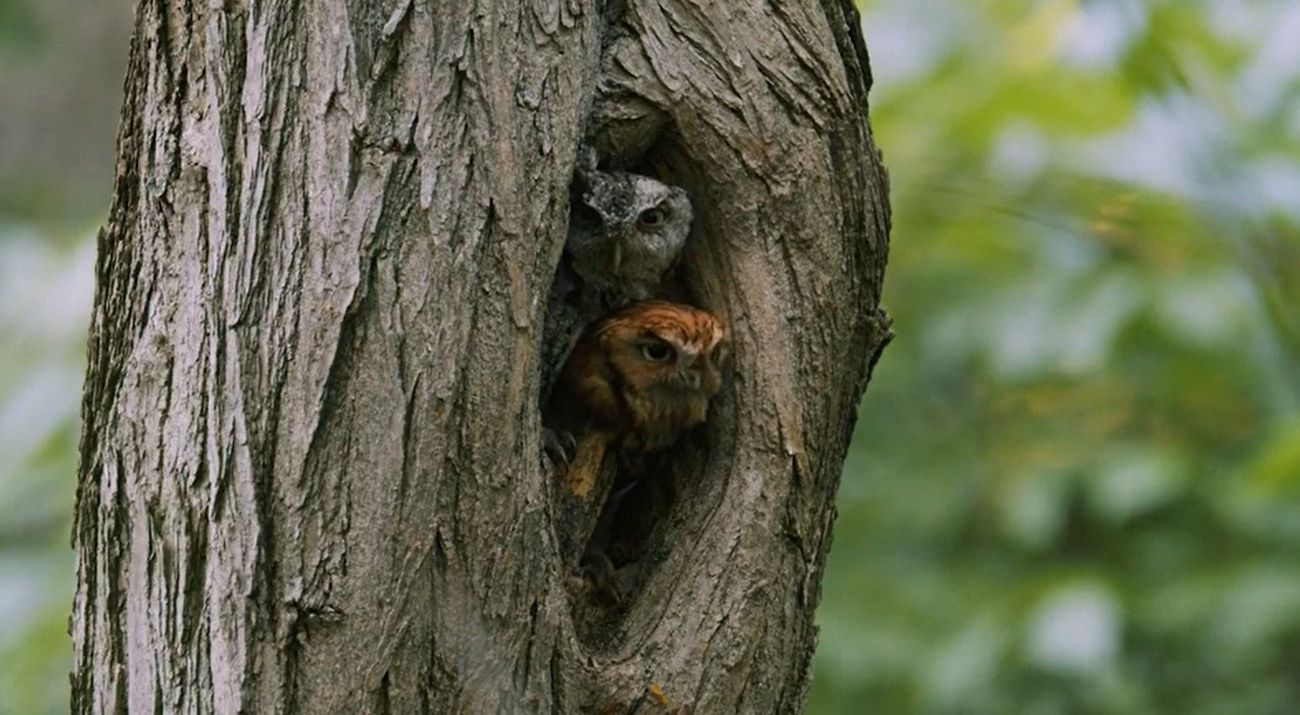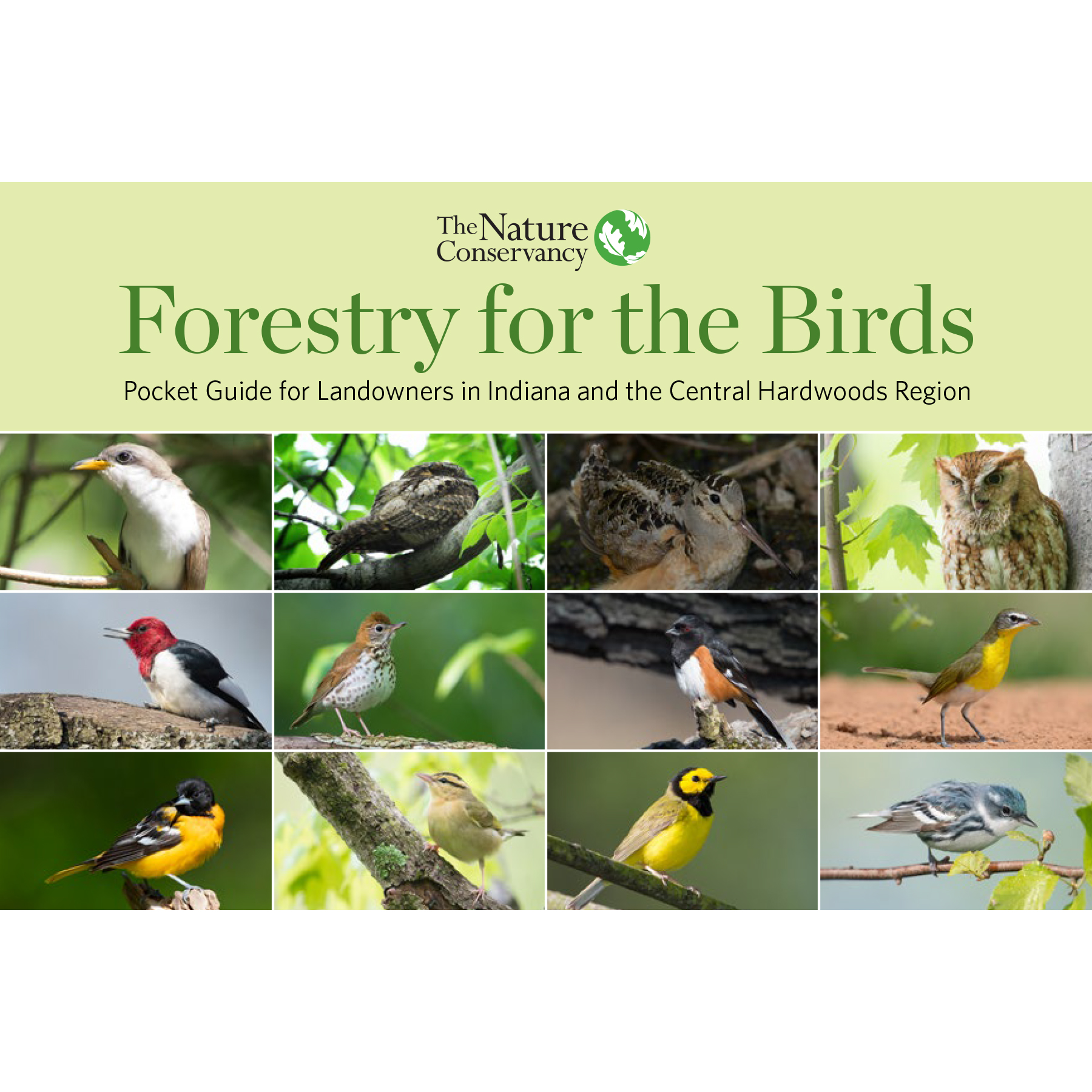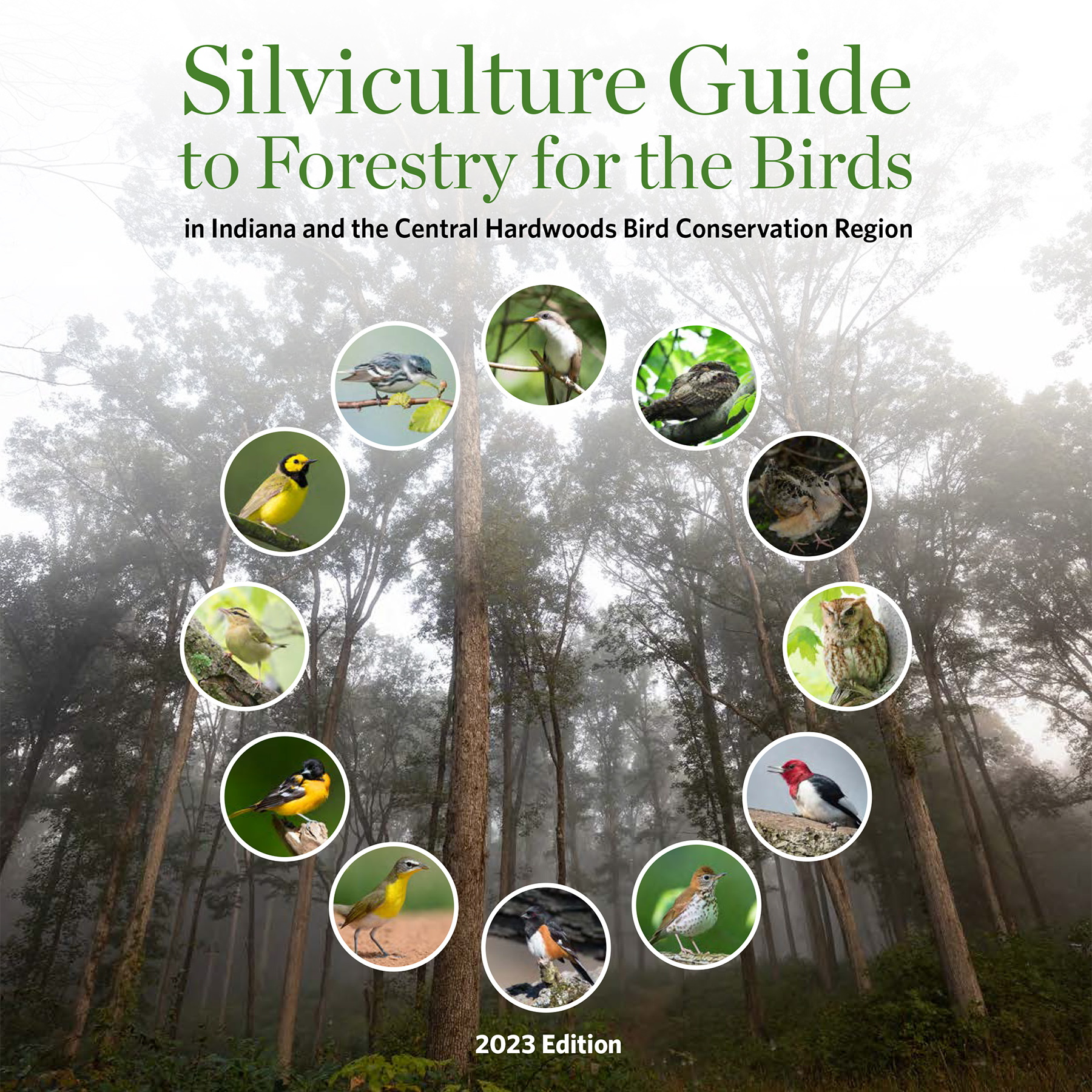
Saving Indiana Songbirds Starts in Our Forests
The diversity of birds is declining with the loss of their habitats. A new TNC project, Forestry for the Birds, brings forest managers and bird lovers together to promote the well-being of both—and all who depend upon them.
By now, even those of us who can't tell a warbler from a woodpecker have likely heard the news: Songbird populations are disappearing at an alarming rate around the world. Since 1970, North America alone has lost more than 2.9 billion birds, according to a recent study published in the journal Science. That adds up to a 29% decline in less than half a century, or more than one in four birds.
And our fate is indeed tied to the birds. From coffee to clean water—not to mention intrigue that drives a nearly $100 billion birdwatching industry—human needs are inextricably linked to the feathered kind in a complex web of life called biodiversity.
Here in Indiana, The Nature Conservancy (TNC) is working to address one of the main causes of the bird decline and that of biodiversity worldwide: habitat loss. Acknowledging that 97% of Indiana's 5 million forested acres are privately held, TNC's Forestry for the Birds provides private landowners with the tools they need for enhanced forest management.
Ensuring a variety of birds thrive for generations to come means promoting a diversity of forest types—old and young, shrubby and tall, from canopy to understory. Working with birders, ornithologists, foresters and wildlife biologists, Forestry for the Birds will support strategies that can benefit both forest management and bird communities.

Forest Landowner
Jerry Long loves the woods at his home in Brown County. As he tells it:
"My wife and I own property in Brown. We have about 168 acres total. We've done a lot of tree planting. We have some areas where we've done some controlled burns. We've done a lot of selective harvesting. If we can get the whole range of forest age and types, that would support all the various bird species.
The motivation is just to do what's right for the environment."
Jerry has been working with a local forester to strategize on how he can create the habitats needed for a wider variety of bird species.

Forester
Perry Seitzinger of Seitzinger Consulting has been assisting with the development of Forestry for the Birds.
"Here in Indiana, we have abundant forests. But what is happening over time, these forests are maturing and becoming older. With a lack of disturbance, we have a lack of age class diversity. There are certain birds that rely on young forests; there are certain birds that rely on old, mature forests; and there are also generalists that need diversity throughout the forest.
Without science-based forest management, we're going to continue to see a population decline in quite a few species of birds."
For Forestry for the Birds, we chose 12 birds we wanted to focus our forest management goals on. Many of these birds are indicators of forest health and forest diversity.
The Birders' Dozen in Indiana
The Birders’ Dozen is a list of thirteen species that were carefully selected for inclusion in this project by The Nature Conservancy and an independent team of birders, ornithologists and conservationists. In general, the species on this list:
- Nest in the Central Hardwoods region
- Are easy to identify by sight and/or sound
- Need conservation action through targeted management, often due to range-wide or local population declines
These birds, with a wide range of habitat requirements, offer a place to start for landowners and professional foresters.

Yellow-billed Cuckoo
Bird call
Bird call: Hollow-sounding single "kik" or "kow" call repeated multiple times.
Yellow-billed cuckoos can be found in woodlands and young forests, often in shrubby habitats along riparian and forest edges. Nests are placed low in dense thickets, most often in humid or moist areas. Their diet includes larger invertebrates, berries and vertebrates such as amphibians and small reptiles.
Fun fact
Cuckoos are sometimes called “raincrows” due to their habit of singing on cloudy days or in response to thunder.

Black-billed Cuckoo
Bird call
Bird call: Triplicate “ku-ku-ku” call repeated multiple times.
Black-billed cuckoos prefer the same habitat as yellow-billed cuckoos—woodlands and young forests, often in shrubby habitats along riparian and forest edges. Both cuckoo species look similar, and the bill color is just one diagnostic feature to distinguish them. However, be aware that juvenile yellow-billed cuckoos also have dark bills!
Like its doppelganger, the black-billed cuckoo feasts on larger invertebrates, berries and vertebrates such as amphibians and small reptiles.
Fun fact
Black-billed cuckoos are secretive and tend to perch motionless for long periods, so finding one can be tricky. Keep your eyes peeled for a long, hunchbacked shape in the middle story of the forest. Even if you think it's just a funny looking branch, it might be worth a second look.

Eastern Whip-poor-will
Bird call
Bird call: Melodic call that sounds like "whip-poor-will," often repeated in near-endless succession.
Eastern whip-poor-wills seek out young forests with open understories and open canopies to make for easier foraging, often nesting on the ground near fallen logs. They especially enjoy flying insects.
Fun fact
Clutches of eggs appear to be timed to the lunar cycle, offering parents more moonlight for foraging when young are growing rapidly. The distinct, melodious “whip-poor-will” call often sounds at dawn and dusk on moonlit nights.

American Woodcock
Bird call
Bird call: Distinct "peent" call given as part of a dramatic courtship display at dawn and dusk in early spring.
American woodcocks prefer young forests or old fields with openings for conducting courtship displays and foraging for earthworms. They also utilize habitat with dense shrub canopies for nesting.
Fun fact
The woodcock often rocks back and forth when foraging to shift weight on its feet, which may cause earthworms near the surface to move—increasing detectability. It also uses its flexible bill to probe for earthworms.

Eastern Screech-owl
Bird call
Bird call: Descending, high-pitched “whinny” is primary song for territory defense; also gives a monotonic, long trill for pair bonding.
Eastern screech-owls prefer woodlands and forests with a suitable cavity tree, but they occupy a wide variety of habitats. Usually, these habitats feature open subcanopy space that lends to hunting a diverse range of prey, as the Eastern screech-owl diet includes both invertebrates such as insects and earthworms and vertebrates such as rodents and songbirds. They can also benefit from manmade nest boxes and can be found near urban and suburban habitats.
Fun fact
Both males and females give the whinny call that gives the screech-owl its name, though males call most frequently; this call is often used to strengthen pair bonds, as these small raptors mate for life.

Red-headed Woodpecker
Bird call
Bird call: Loud, high-pitched “churr” or “queear”; also drum on trees and other tall structures as territory defense and pair formation.
Red-headed woodpeckers need snags for nesting and mating displays, as well as dead wood for foraging. They prefer open woodlands, canopies, light shrub layers and oak savannas, which they occupy consistently. In winter, these woodpeckers seek out mature stands of oak forest.
Fun fact
Unlike most woodpeckers in eastern North America, both sexes of the red-headed woodpecker look similar—a species feature known as sexual monomorphism. Their bold coloration has earned them the nickname “flying checkerboard.”

Wood Thrush
Bird call
Bird call: Wood flute-like, melodic song with variable patterns and "CAW CAW CAW" in the background.
Wood thrushes depend on interiors of mature, deciduous and mixed forest with open understories and a moist, well-developed leaf-litter layer. They nest in dense shrubs or saplings for concealment but utilize mature forests with open understories otherwise, feasting on soil invertebrates and native, lipid-rich fruits.
Fun fact
The structure of the wood thrush’s syrinx—better known as a voicebox—is a unique Y-shape that allows it to sing two harmonious notes simultaneously, contributing to the ethereal quality of its song. At dawn and dusk, males offer a wood flute-like, melodic song, often with variable patterns.

Eastern Towhee
Bird call
Bird call: Described as “drink your tee-ee-ea” or “see tow-hee-ee,” often given from high, visible perches.
Eastern towhees often use tall trees for singing and mate attraction but spend the majority of their time near the forest floor in young forests, particularly ones with dense shrub layers that offer concealment for nesting and leaf litter for foraging terrestrial invertebrates, seeds and fruits in late summer.
Fun fact
The color of a towhee’s eye can tell you how old the bird is. Younger birds have dark brown eyes, while mature adults have red eyes. In some parts of the Southeast, however, towhees have white eyes.

Yellow-breasted Chat
Bird call
Bird call: Long, variable series of whistles, squirrel-like chatters, and high-pitched calls.
Yellow-breasted chats prefer low, dense, shrubby areas with open canopies in early successional forests. These dense shrub layers support foraging and the concealing of nests, which the birds place in the shrubs roughly three feet above the ground.
Fun fact
This bird was once considered a warbler, but its unique lifestyle, song and behavior have made it the sole member of its own family.

Baltimore Oriole
Bird call
Bird call: Rich, whistling song in a short series of paired notes.
Baltimore orioles, while often seen at backyard feeders, can be found in a variety of wooded habitats such as riparian edges, open woodlands and deciduous forest edges. They often nest in large trees, either isolated or on the forest edges.
Fun fact
Both the city in Maryland and the bird were named for the same thing—the Baltimore family of England, whose heraldry bears striking orange-and-black coloration. For two decades, between 1973 and 1995, Baltimore and Bullock’s orioles were collectively considered the “northern oriole” until it was discovered that they were in fact separate species, much to the rejoicing of the city and the Major League Baseball team.

Worm-eating Warbler
Bird call
Bird call: Insectlike trill, similar to chipping sparrow but differentiated by slightly higher pitch and smoother trill.
Worm-eating warblers tend to prefer mature forests on steep slopes but move into young forest and shrubby areas during some portions of their lives. They prefer the understory of shrub patches in large, mature forests, often on slopes, as well as regenerating clearings during post-fledging period. Nests are usually placed on slopes in patches of dense shrub cover.
Fun fact
This small warbler—rather than directly foraging insects like caterpillars and spiders on the forest floor on which it nests—often hops through the understory and forages near the ground, but not on it.

Hooded Warbler
Bird call
Bird call: Rocking, melodic call described as “weeta-weeta-weeTEEyoo.”
Hooded warblers are mature forest birds that specialize in gaps: tree-fall gaps, single-tree selection harvests and other areas with small, dense shrub areas for nest placement and an open canopy within a large forest context. Their diet includes insects and spiders.
Fun fact
During the winter, males and females are territorial and defend different habitat types, with males often being found in older, mature forest while females often defend younger, more shrubby forest areas.

Cerulean Warbler
Bird call
Bird call: Three-parted, low-pitched but rising and accelerating “tew-tew-tewchee-chee-chee-BYZZ.”
Cerulean warblers specialize in mature deciduous forest canopies. They prefer large areas of structural diversity—often tracts 75 acres or greater with canopy gaps that provide concealment for nests and spaces to forage for insect prey.
Fun fact
The distinct sky-blue color of the male cerulean warbler and the aqua-green of the female is not due to pigment in feathers but is rather a result of feather structures that reflect blue wavelengths of light.
Resources
-

Forestry for the Birds Pocket Guide
This Pocket Guide provides bird-focused information about habitat management for landowners and managers, but particularly those interested in managing their lands for birds. View/Download the Pocket Guide
-

Forestry for the Birds Silviculture Guide
This Guide is intended as a support document for writing forest and wildlife management plans. View/Download the Silviculture Guide
We can't save nature (or the birds) without you
Sign up to receive regular updates from Indiana.